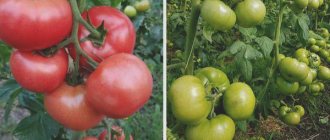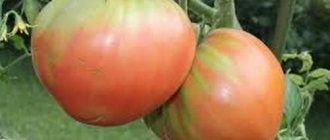Tomato Pink Spam: variety description
| Variety name | Pink Spam |
| general description | Early maturing hybrid of indeterminate type |
| Originator | Russia |
| Ripening period | 95-100 days |
| Form | Heart-shaped |
| Color | Pink |
| Average weight of tomatoes | 160-300 grams |
| Application | Table variety |
| Productivity of the variety | 20-25 kg per square meter |
| Features of cultivation | Agricultural technology is standard, requires the formation of bushes |
| Disease resistance | Prevention of fungal diseases is necessary |
The origin of this hybrid variety is related to the traditional Bull's Heart.
From him, Pink Spam inherited the specific growth, color and size of the fruit. According to the type of development, this is an indeterminate plant that requires support. Indeterminateness is the ability of a plant to grow throughout the entire growing period. Read about determinate varieties here. You can stop the plant’s tendency to rise up and to the sides by pinching it at the desired height, removing excess trunks and branches, that is, pinching. Tomatoes of this variety are early ripening: from germination to the beginning of fruit ripening 95 - 100 days.
In the southern regions, Pink Spam tomatoes can be grown in open ground, but, being a hybrid, they develop better in greenhouses, greenhouses and under film. In them, tomatoes successfully resist cladosporiosis, verticellosis and tomato mosaic virus. Resistance to late blight is not the highest.
Technological operations for growing tomatoes
Growing tomatoes for gardeners does not pose any particular difficulties, but not everyone is able to obtain a high-quality product. The yield of the crop depends on the growing technology, the characteristics of the tomato variety, and climatic conditions.
Description of the tomato variety Apples on the snow, its characteristics and yieldRead
Soil preparation
To rationally use the space of a greenhouse or garden when growing tomatoes, the seedling method is used. Seeds are sown in special containers with drainage holes or cassettes, then transferred to a permanent place.
Ordinary soil is not suitable for planting tomato seeds for seedlings, so a suitable nursery needs to be filled with seeding substrate.
Unlike other vegetables, tomatoes grow well in salty and highly acidic soils. The removal of nutrients from the soil per 1 ton of fruit is N - 3.2; P2 O5 - 1.1; K2 O - 4.6.
The land required for planting tomato seedlings must meet the following requirements:
- high porosity - 65 - 75%;
- low moisture capacity - 45 - 50%;
- air capacity - 20 - 25%;
- density - 0.4 - 0.6 g/cm².
Planting seeds
Tomatoes are very picky about temperature. Tomatoes should be sown when the soil warms up to 16 °C. The normal growth and ripening time of this tomato variety depend on temperature.
| Development phase | Optimal temperature value, °C | ||
| Daytime | Night | Average daily | |
| Sowing | 22 – 24 | 22 – 24 | 22 – 24 |
| Seedling | 20 – 22 | 18 – 19 | 21 – 23 |
| Dive | 20 – 21 | 19 – 20 | 19 – 21 |
| Planting in a greenhouse | 20 – 21 | 17 – 18 | 18 – 20 |
| Growing season | 20 – 22 | 17 – 19 | 17 – 20 |
| Fruiting period | 20 – 22 | 17 – 19 | 17 – 20 |
Sowing of seeds is carried out to a depth of 0.5 - 1 cm at a distance of 2 cm, the distance between rows is 4 cm. To sow tomatoes, use a hand seeder or a toothpick soaked in water. After this, the substrate is sprinkled with earth and moistened with warm water.
Before sowing, you can check the germination of seeds. To do this, lower the planting material into a container of water for a few minutes. Those tomato seeds that sink to the bottom of the container are considered suitable for planting.
Characteristics and description of the tomato variety Gift for a womanRead
Next, the cassettes or boxes are covered with film and transferred to a bright, dry place without drafts. The first and important point for obtaining friendly shoots is maintaining humidity within 75 - 80% before germination. To do this, water the tomato nursery at least once a week.
Seedling care
The place where the seedlings grow should be well ventilated. The air temperature should be within 18 degrees, during the transplantation period - 16 °C. When two true sheets appear, the picking process is carried out. This usually happens 11 - 12 days after sowing. Tomato bushes should be replanted in a place with good lighting, but without direct sunlight.
During this period, the first feeding of tomatoes with complex fertilizer (superphosphate, azophosphate, potassium nitrate) is carried out. The second feeding is carried out two weeks later. When the seedlings reach 20 cm in height, after the appearance of 9 - 10 well-developed leaves, they must be planted in a permanent place of growth.
Planting on the beds
Depending on the germination temperature and region, the transplantation period begins from April 15 to May 15. It should be planted in fluffy soil fertilized with organic fertilizer. In order for the bed to warm up evenly, it is necessary to plant in the north-south direction - this way the tomatoes will not shade each other, which will make it possible to obtain evenly aligned seedlings.
For indeterminate varieties of tomatoes, a two-band planting scheme is used: row spacing - 60 - 70 cm, between adjacent beds - 90 - 100 cm, distance in the row - 50 - 55 cm.
Characteristics
The fruits are multi-chambered with medium density and thin skin. They contain more nutrients, vitamins, micro- and macroelements than tomatoes of the original variety. The taste is sweetish . Their color is more pink. The shape of tomatoes on one bush is aligned, heart-shaped, less often – round.
Fruit weight is from 160 to 300 g . Immediately after harvesting, the fruits tolerate transportation well, but are not intended for long-term storage. A hybrid of domestic selection, registered in the Russian Federation and included in the State Register as Tomato Pink Spam F1 for cultivation in film greenhouses of private farms.
You can compare the weight of fruits with other varieties in the table below:
| Variety name | Fruit weight |
| Pink spam | 160-300 grams |
| Room surprise | 25 grams |
| Mystery | 75-110 grams |
| King of Siberia | 400-700 grams |
| Dimensionless | up to 1000 grams |
| Visibly-invisibly | 280-330 grams |
| Crystal | 130-140 grams |
| Kate | 120-130 grams |
| Caspar | 80-120 grams |
| Nastenka | 50-70 |
Tomato variety Pink Spam - table. Tasty, juicy, large fruits with thin skin are used fresh for preparing salads and sauces. For use in winter, juice with pulp, tomato paste and seasonings (for example, adjika) are prepared.
If the agrotechnical minimum is observed, the yield of the Pink Spam variety is above average: 20 – 25 kg per 1 m². This is more than the productivity of many other tomato varieties. You can compare it in this table:
| Variety name | Productivity |
| Pink Spam | 20-25 kg per square meter |
| Red bunch | up to 10 kg per bush |
| Gulliver | 7 kg per bush |
| Bella Rosa | 5-7 kg per square meter |
| Countryman | 18 kg per square meter |
| Golden Jubilee | 15-20 kg per square meter |
| Diva | 8 kg per bush |
| Rose of Wind | 7 kg per square meter |
| The Golden Fleece | 8-9 kg per square meter |
| Explosion | 3 kg per bush |
Collection and storage
Pink tomato fruits are harvested daily: do not allow the crop to overripe, as tomatoes are prone to cracking. Harvesting is carried out until the air temperature drops below 10 degrees. Mature specimens are stored for no more than five days. These fruits are used for fresh consumption, as well as for making paste or tomato juice. Tomatoes at the initial stage of ripeness are harvested for long-term storage. Only healthy and whole fruits at the milk stage of maturity are selected for storage. Tomatoes are placed in clean and dry wooden boxes with the stalks facing up. Hay or hardwood shavings are placed at the bottom of the box. Optimal conditions are a dark, dry room with good ventilation. Pink tomatoes are best stored at a temperature of 1-2 degrees.
Advantages and disadvantages
An undoubted advantage over other varieties of tomatoes is:
- high productivity;
- friendly fruit setting;
- no tendency to crack;
- excellent taste;
- high content of useful substances.
The hybrid has much fewer disadvantages:
- more complex care;
- low keeping quality;
- susceptibility to certain diseases.
Pros and cons of the variety
Each variety has its own positive and negative sides, although some tomatoes lack the latter. You can see the pros and cons of Pink Spam in the following table.
| Advantages | Flaws |
| High yield | Difficult to care for |
| The fruits set together | The fruits don't last long |
| Tomatoes practically do not crack | It is necessary to tie up bushes and remove stepchildren |
| High quality taste | Low resistance to late blight |
| Tomatoes contain large quantities of nutrients | |
| Rapid ripening after picking from the bush | |
| The long period of fruiting begins in June and ends with the onset of frost. |
Features of cultivation
The growth of the hybrid and its yield largely depend on the growing conditions. Each bush requires shaping to achieve the greatest yield.
The Pink Spam tomato variety is most often grown through seedlings . Seeds are sown in March using growth stimulants; two-month-old plants are transferred to a greenhouse or open ground for cultivation with or without cover.
From a very early age, the bush requires formation. This regular procedure is especially relevant in conditions of limited greenhouse space. The plant is formed into 1 trunk . Much attention is paid to the removal of stepchildren. These shoots thicken the bush and use up nutrients, which negatively affects the yield.
Tall varieties require increased lighting. To achieve this, the bush is tied to a vertical support as early as possible and pinching is carried out regularly. The plant also needs fresh air and not too high a temperature.
Reference: At temperatures above +33°C during flowering, the ability to form ovaries is significantly reduced.
The variety very quickly uses nutrients from the soil and needs additional feeding. During the growth period, phosphorus-potassium fertilizers are applied, which significantly increases the yield. The following are also used as fertilizers:
- Organic.
- Mineral.
- Yeast.
- Iodine.
- Hydrogen peroxide.
- Ammonia.
- Ash.
- Boric acid.
Watering is regular, but not excessive . Excessive watering after severe drought is dangerous. No matter how resistant the variety is to cracking, waterlogging after the soil has completely dried is very dangerous for the integrity of the fruit. Mulching during planting will help prevent weeds.
Landing
The growth of the variety and the quality of fruiting are influenced by growing conditions. The best option is the seedling method of cultivation with further planting under film cover.
Growing seedlings
It is recommended to sow Pink Spam seeds for seedlings approximately 2 months before planting in the ground: mid-March - early April (depending on the region). Before this they need to be prepared:
- place the seeds for 30 minutes in a weak solution of potassium permanganate;
- rinse with water;
- prepare a stimulant by diluting 1 teaspoon of honey in 1 glass of water;
- place the seeds in the resulting solution for 1 hour;
- take out the planting material and dry it by spreading it on a sheet of paper.
Next, you need to buy soil in a specialized store or prepare it yourself:
- take an equal amount of soil (preferably from the area where the tomatoes will grow), river sand, peat;
- add a little wood ash - it will reduce the acidity of the soil and disinfect it;
- disinfect the resulting substrate with potassium permanganate.
You can start planting tomato seedlings Pink Spam:
- spread the prepared planting material on the surface of soil preheated to 100°C or spilled with boiling water;
- sprinkle 1 cm of substrate on top;
- cover the container with the crops with glass or a piece of transparent film;
- place in a warm place.
At a room temperature of approximately +25°C, the first shoots will appear in 5 – 7 days. Remove the glass (film) and place the seedlings in a bright, warm place that is not exposed to direct sunlight. Periodically moisten the substrate with a spray bottle, being careful not to get it on the fragile leaves.
When the first true leaf appears, plant the sprouts in larger pots. Water the seedlings at the roots as the soil dries out. Feed the crop with fertilizer:
- the first time - 10 days after the pick;
- the second time - 2 weeks after the first feeding;
- the last time - about 2 weeks before planting in the ground.
2 weeks before planting, begin to take the young shoots outside for a short time to adapt and harden them. After the end of night frosts (approximately the 3rd decade of May), the seedlings can be planted in the ground.
Recommendation: to avoid bending the roots during the picking process, replant the seedlings, leaving a lump of earth on the roots.
Landing in the ground
To plant seedlings in open ground, the beds are prepared in advance: they are dug up in the fall and fertilized with manure. It is advisable to make the beds on the south side of the site, on low-acid sandy or loamy soil. It is not advisable to plant Pink Spam on land on which eggplants, potatoes, and sweet peppers previously grew. The ideal predecessors of tomatoes are cabbage, onions, and zucchini.
The period for planting seedlings in open ground is approximately from May 20 (after the cessation of morning frosts) to June 15. By this time, the seedlings should:
- purchase 7 leaves;
- grow up to 20 cm in height.
The optimal planting patterns are 50x50 cm, 60x60 cm or 70x40 cm. The bushes must be tied up, they must be formed into 1 - 2 stems. Planting in a greenhouse is carried out 2 weeks earlier than in open ground.
Information: in order for the fruits to grow large and even, their quantity must be normalized. From 4 to 6 ovaries are left in the brush, and the rest are discarded.
Diseases and pests
Like many hybrid representatives of the nightshade family, these tomatoes are not too susceptible to attack by pests. They are afraid only of certain fungal diseases, in particular late blight.
To prevent the development of fungal diseases, the greenhouse is regularly ventilated to remove excess air humidity. Before planting seedlings in a greenhouse, the soil is treated with phytosporin or another antifungal drug.
Read more about how to protect plants from late blight and which varieties are resistant to this disease? What are Alternaria, Fusarium and Verticillium? Which varieties are resistant to most diseases? Why are fungicides and insecticides used when growing tomatoes? What are the most common diseases of tomatoes in greenhouses and how to treat them?
Thus, the Pink Spam tomato hybrid is a promising high-yielding table variety that deserves the attention of gardeners.
The main rules for sowing seeds for seedlings
To obtain a guaranteed harvest with the declared varietal characteristics, seed material must be purchased from reliable, trusted manufacturers. Early tomatoes are sown as seedlings at the end of March.
Check out the diagram for placing tomatoes in a 3x6 greenhouse.
Obtaining healthy, viable seedlings directly depends on following certain recommendations at each stage of cultivation:
- Seed preparation. Dried seeds are sown in the substrate without additional processing. Seeds without a shell are first soaked for a quarter of an hour in a solution of “Fitosporin” or in a 1% solution of potassium permanganate, then in a growth stimulator according to the manufacturer’s instructions.
- Substrate preparation. The soil is used ready-made for nightshade crops or mixed independently from equal parts of peat, humus and turf soil. Add 1 liter of river sand and 1 tablespoon each of superphosphate and wood ash to a bucket of the mixture. Before use, such soil is calcined in the oven or spilled with a solution of potassium permanganate for disinfection. To sow tomatoes for seedlings, you can use peat cups or tablets. Such sprouts do not need picking and are planted in a permanent place along with the container without damaging the root ball.
- Sowing scheme. The soil is placed in wooden or plastic boxes, grooves 1–1.5 cm deep are made on the surface at a distance of 4–6 cm from each other and watered with settled water heated to +20°C. The prepared seeds are laid out in furrows in increments of 1.5–2 cm, covered with soil mixture, lightly compacted, and covered with glass or film, removing it daily for ventilation.
- Caring for seedlings. During the first week for seed germination, the boxes are kept at a temperature of +22...+25°C. After germination, the seedlings are transferred to a well-lit place and kept during the day at +16...+18°C, and at night at +13...+15°C. After another week, the daytime temperature rises to +21...+25°C, and the night temperature to +16...+18°C. Watering is carried out as the soil surface dries with warm, settled water.
- Picking. Seedlings are planted in individual containers at the age of 2–3 true leaves. 2 weeks after picking, feed with complex fertilizer, diluting it twice as weak as indicated in the instructions.
Useful video
Watch the video: the benefits of pink tomatoes
In the table below you will find useful links about tomato varieties with different ripening periods:
| Mid-late | Mid-early | Super early |
| Volgogradsky 5 95 | Pink Bush F1 | Labrador |
| Krasnobay F1 | Flamingo | Leopold |
| Honey fireworks | Mystery of nature | Shchelkovsky early |
| De Barao Red | New Koenigsberg | President 2 |
| De Barao Orange | King of the Giants | Lyana pink |
| De Barao Black | Openwork | Locomotive |
| Miracle of the market | Chio chio san | Sanka |
How to care for tomatoes
| Stage 1. Landing Step 1. The recommended planting period for this variety is early or mid-May. Plant in open ground in the second half of May. Pre-fertilize and dig up the soil. Step 2. Plant according to the 60x70 cm pattern, since the bushes are demanding on lighting | |
| Stage 2. Watering Step 1. Let the water stand for 24 hours before use. Step 2 : Water in the evening after sunset. For 1 plant – 5-7 liters of water | |
| Stage 3. Feeding Step 1. Observe the frequency of feeding - once every 3 weeks. Step 2. For best results, alternate between mineral and organic formulations. | |
| Stage 4. Loosening and weeding Step 1. Loosen the surface around the stems after each watering. In open ground, loosen even after rains. Step 2: Remove weeds every 1-2 weeks while they are still small | |
| Stage 5. Tying Option 1. A peg is driven in near each bush and the tomato trunk is tied to it in 2-3 places. Option 2. The crossbar is fixed above the plants. Pieces of twine are attached to it and wrapped around the tomatoes. | |
| Stage 6. Timely harvesting Step 1. Remove ripe fruits to prevent them from taking nutrients from the plant. Step 2. Be sure to remove all rotten and spoiled tomatoes. |
Bright hybrid
Thanks to the tireless work of breeders, new varieties of tomatoes are being created not only with a variety of sizes and shapes, but also in color. Among them, the Orange Spam tomato stands out; reviews from summer residents indicate its early fruiting and excellent taste. Its indeterminate, tall bushes require mandatory support and garter.
They produce the first harvest within 3-3.5 months after germination. The hybrid variety is used for protected soil, but also grows well in open beds. It is characterized by high resistance against viral and bacterial diseases of tomatoes. In the maturity stage:
- juicy, fleshy tomatoes acquire a golden orange color and a very pleasant taste;
- each brush produces 6 tomatoes weighing up to 180 g, which are distinguished by their excellent presentation;
- Tomato yield is up to 20 kg/sq. m.
Tomato Orange Spam, thanks to its bright appearance, is a wonderful table decoration and an excellent component of any vegetable salad.
How to grow seedlings
| Stage 1. Purchasing seeds Step 1. Since this is a hybrid variety, you won’t be able to collect the seeds yourself. They must be purchased every year. Step 2: Buy seeds only from reputable stores. Avoid street vendors and market stalls, the planting material there is of low quality | |
| Stage 2. Disinfection Step 1. Seed manufacturers recommend treating the seeds with a solution of potassium permanganate to eliminate infections; for this, a weak solution is prepared, as in the photo. Step 2. Dip the seeds into the solution and let sit for 15 to 20 minutes. Then remove the seeds and rinse with clean water | |
| Stage 3. Treatment with a growth stimulator Step 1: Another recommended step to increase germination and improve root formation. Buy any growth stimulant in the store. Step 2. Treat the seeds as indicated in the instructions. Maintain the proportions of the components | |
| Stage 4. Sowing seeds Step 1. The recommended planting period is the second half of February or early March. Prepare a container and fill it with soil for seedlings. Step 2. Plant the seeds to a depth of 10 mm. Place in a warm place, after germination, move to the windowsill | |
| Stage 5. Picking Step 1. After several true leaves appear, plant the tomatoes in separate containers. Step 2. Pinch the central root before transplanting to encourage branching of the lateral roots. | |
| Stage 6. Caring for seedlings Step 1: Spray the plants with water in the morning and evening. Water once a week. Step 2: Feed twice during cultivation. Step 3. A week before transplanting, start hardening - open the window on warm days for 2-3 hours |










